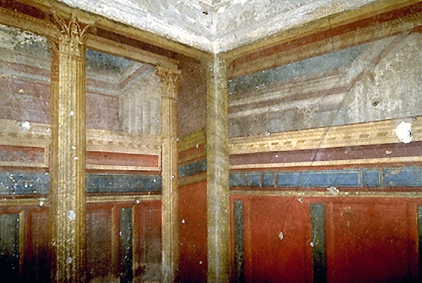 1>
1>The transition from marble imitation to increasingly architectural images was initially discussed by August Mau, but only in formal terms. For him, it simply indicated a stylistic shift from what he termed the Incrustation Style to the Architectural Style. Now generally referred to as the First and Second Style. He attached no psychological imperative to it. Not even when the pictorial wall stopped short of the top of the actual wall, thus offering the viewer an illusion of vistas beyond the simulacrum and, by implication, its physical counterpart.
The previously planar and enclosing characteristics of the pictorial wall were increasingly breached by an opening that was initially confined to a narrow strip at the top of the wall (fig.1). The narrow strip then gradually increased in size as the ledge of the wall was lowered to reveal more of the vista that lay beyond (fig.2).
To a greater or lesser extent all paintings deny and confirm the surface upon which they are painted, even those that subscribe to Clement Greenberg's desire for non-illusionistic “truth”. By its very nature paint covers and therefore it physically and conceptually changes the surface that it is applied to. However, what is remarkable in this ancient context is that the paradigm shift did not take place within the self-contained space of an easel painting that is normally defined by a frame, which in turn separates it from its surroundings in the physical world. The emerging Architectural or Second Style, in contrast, created its own environmental sphere of reference that was very much linked to its immediate surroundings. It was simultaneously a pictorial space and the framework that defined the environment in which it existed.
In the early years of the first century BC the physical environment within the house was increasingly reconfigured through the use of wall-painting. Trompe l’oeil walls not only optically substituted for actual walls, but they also initiated a visual discourse that resonated beyond the confines of the room itself.
|